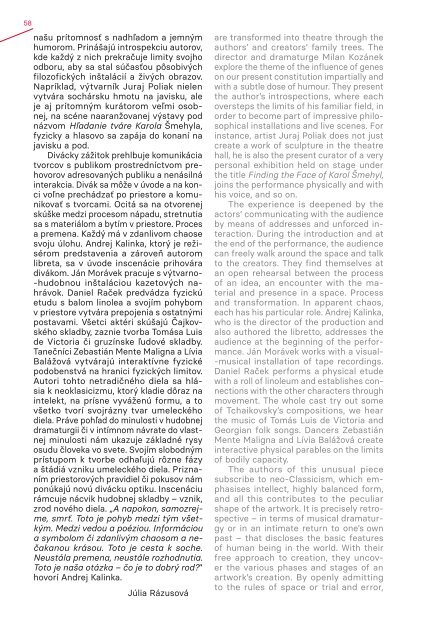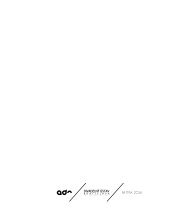Divadelná Nitra 2019 Catalogue
You also want an ePaper? Increase the reach of your titles
YUMPU automatically turns print PDFs into web optimized ePapers that Google loves.
58<br />
našu prítomnosť s nadhľadom a jemným<br />
humorom. Prinášajú introspekciu autorov,<br />
kde každý z nich prekračuje limity svojho<br />
odboru, aby sa stal súčasťou pôsobivých<br />
filozofických inštalácií a živých obrazov.<br />
Napríklad, výtvarník Juraj Poliak nielen<br />
vytvára sochársku hmotu na javisku, ale<br />
je aj prítomným kurátorom veľmi osobnej,<br />
na scéne naaranžovanej výstavy pod<br />
názvom Hľadanie tváre Karola Šmehyla,<br />
fyzicky a hlasovo sa zapája do konaní na<br />
javisku a pod.<br />
Divácky zážitok prehlbuje komunikácia<br />
tvorcov s publikom prostredníctvom prehovorov<br />
adresovaných publiku a nenásilná<br />
interakcia. Divák sa môže v úvode a na konci<br />
voľne prechádzať po priestore a komunikovať<br />
s tvorcami. Ocitá sa na otvorenej<br />
skúške medzi procesom nápadu, stretnutia<br />
sa s materiálom a bytím v priestore. Proces<br />
a premena. Každý má v zdanlivom chaose<br />
svoju úlohu. Andrej Kalinka, ktorý je režisérom<br />
predstavenia a zároveň autorom<br />
libreta, sa v úvode inscenácie prihovára<br />
divákom. Ján Morávek pracuje s výtvarno‐<br />
‐hudobnou inštaláciou kazetových nahrávok.<br />
Daniel Raček predvádza fyzickú<br />
etudu s balom linolea a svojím pohybom<br />
v priestore vytvára prepojenia s ostatnými<br />
postavami. Všetci aktéri skúšajú Čajkovského<br />
skladby, zaznie tvorba Tomása Luis<br />
de Victoria či gruzínske ľudové skladby.<br />
Tanečníci Zebastián Mente Maligna a Lívia<br />
Balážová vytvárajú interaktívne fyzické<br />
podobenstvá na hranici fyzických limitov.<br />
Autori tohto netradičného diela sa hlásia<br />
k neoklasicizmu, ktorý kladie dôraz na<br />
intelekt, na prísne vyváženú formu, a to<br />
všetko tvorí svojrázny tvar umeleckého<br />
diela. Práve pohľad do minulosti v hudobnej<br />
dramaturgii či v intímnom návrate do vlastnej<br />
minulosti nám ukazuje základné rysy<br />
osudu človeka vo svete. Svojím slobodným<br />
prístupom k tvorbe odhaľujú rôzne fázy<br />
a štádiá vzniku umeleckého diela. Priznaním<br />
priestorových pravidiel či pokusov nám<br />
ponúkajú novú divácku optiku. Inscenáciu<br />
rámcuje nácvik hudobnej skladby – vznik,<br />
zrod nového diela. „A napokon, samozrejme,<br />
smrť. Toto je pohyb medzi tým všetkým.<br />
Medzi vedou a poéziou. Informáciou<br />
a symbolom či zdanlivým chaosom a nečakanou<br />
krásou. Toto je cesta k soche.<br />
Neustála premena, neustále rozhodnutia.<br />
Toto je naša otázka – čo je to dobrý rod?”<br />
hovorí Andrej Kalinka.<br />
Júlia Rázusová<br />
are transformed into theatre through the<br />
authors’ and creators’ family trees. The<br />
director and dramaturge Milan Kozánek<br />
explore the theme of the influence of genes<br />
on our present constitution impartially and<br />
with a subtle dose of humour. They present<br />
the author’s introspections, where each<br />
oversteps the limits of his familiar field, in<br />
order to become part of impressive philosophical<br />
installations and live scenes. For<br />
instance, artist Juraj Poliak does not just<br />
create a work of sculpture in the theatre<br />
hall, he is also the present curator of a very<br />
personal exhibition held on stage under<br />
the title Finding the Face of Karol Šmehyl,<br />
joins the performance physically and with<br />
his voice, and so on.<br />
The experience is deepened by the<br />
actors’ communicating with the audience<br />
by means of addresses and unforced interaction.<br />
During the introduction and at<br />
the end of the performance, the audience<br />
can freely walk around the space and talk<br />
to the creators. They find themselves at<br />
an open rehearsal between the process<br />
of an idea, an encounter with the material<br />
and presence in a space. Process<br />
and transformation. In apparent chaos,<br />
each has his particular role. Andrej Kalinka,<br />
who is the director of the production and<br />
also authored the libretto, addresses the<br />
audience at the beginning of the performance.<br />
Ján Morávek works with a visual‐<br />
‐musical installation of tape recordings.<br />
Daniel Raček performs a physical etude<br />
with a roll of linoleum and establishes connections<br />
with the other characters through<br />
movement. The whole cast try out some<br />
of Tchaikovsky’s compositions, we hear<br />
the music of Tomás Luis de Victoria and<br />
Georgian folk songs. Dancers Zebastián<br />
Mente Maligna and Lívia Balážová create<br />
interactive physical parables on the limits<br />
of bodily capacity.<br />
The authors of this unusual piece<br />
subscribe to neo ‐Classicism, which emphasises<br />
intellect, highly balanced form,<br />
and all this contributes to the peculiar<br />
shape of the artwork. It is precisely retrospective<br />
– in terms of musical dramaturgy<br />
or in an intimate return to one’s own<br />
past – that discloses the basic features<br />
of human being in the world. With their<br />
free approach to creation, they uncover<br />
the various phases and stages of an<br />
artwork’s creation. By openly admitting<br />
to the rules of space or trial and error,




